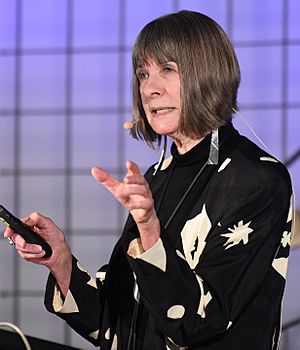Dean Falk facts for kids
Quick facts for kids
Dean Falk
|
|
|---|---|

Falk in 2017
|
|
| Born | June 25, 1944 (age 81) |
| Nationality | American |
| Alma mater | University of Michigan |
| Occupation | Anthropologist |
| Organization | Florida State University |
Dean Falk (born June 25, 1944) is an American scientist who studies the brain and how it changed over time in humans and other primates. She is a professor of anthropology and a distinguished research professor at Florida State University. Her work helps us understand how our brains became so complex.
Contents
Dean Falk's Career and Discoveries
Early Studies and Brain Evolution Ideas
Dean Falk studied math and anthropology in college. After earning her PhD in 1976, she taught classes about the body, the brain, and human history. She is very interested in how the brain and thinking skills have evolved.
Falk came up with the "radiator theory." This idea suggests that blood vessels in the head were important for cooling the brain. This cooling might have helped human brains grow larger. She also proposed the "putting the baby down" idea. This theory suggests that when prehistoric mothers put their babies down, it helped language develop.
Studying Ancient Brains and Famous Minds
In 2005, Dean Falk and her team described the brain of Homo floresiensis. This ancient human is sometimes called the "Hobbit" because of its small size. Later, in 2013, Falk and her colleagues studied the brain of famous scientist Albert Einstein. They looked at new photos of his brain to understand its unique features.
In 2017, Falk worked on a study about warfare in different societies. This research looked at whether people are less violent today than they were in the past.
Understanding Homo floresiensis
The Discovery of the "Hobbit"
In 2003, scientists found the bones of a small human on an island in Indonesia. This discovery was named Homo floresiensis, or the "Hobbit." These remains are now known to be over 65,000 years old.
Some scientists thought this small human might have been a pygmy. Others believed it was a person with microcephaly. Microcephaly is a rare condition where a person is born with an unusually small head and brain.
Falk's Research on the "Hobbit" Brain
Dean Falk led a study in 2005 to examine the "Hobbit's" brain. They made a model of the inside of its skull, called an endocast. This model showed the shape of the brain. Falk's study supported the idea that the "Hobbit" was a new species of human, not just a person with a condition.
Some experts questioned Falk's findings. So, in 2007, Falk worked with an international team. They compared the "Hobbit's" brain shape to those of people with microcephaly. Their research confirmed that Homo floresiensis was indeed a distinct species. They also showed that the "Hobbit" was not a human with microcephaly, Laron syndrome, or Down syndrome. Today, most experts agree that the "Hobbit" was a unique ancient human species.
Exploring Human Brain Evolution
Einstein's Brain and Fossil Clues
In 2013, Dean Falk led a team that described the entire outer layer of Albert Einstein's brain. This part is called the cerebral cortex. She also worked with other scientists to analyze his corpus callosum, which connects the two halves of the brain.
In 2014, Falk published work about what we can learn from fossil brains. Scientists who study ancient brains are called paleoneurologists. They can learn about how brain size changed and how certain parts of the brain reorganized over time.
The Cerebral Cortex and Its Importance
Falk noted that the cerebral cortex is a very advanced part of the human brain. It helps us with conscious thought, planning, language, and social skills. It also plays a role in our creativity in science, art, and music. Sometimes, the cerebral cortex leaves marks inside skulls, which can be seen on endocasts.
However, Falk also pointed out that paleoneurologists cannot study the internal parts of the brain from fossils. These inner parts are also very important. They help us process memories, feelings, and social interactions. These internal structures are a big part of what makes human brains different from other animals.
Comparing Ancient and Modern Brains
In 2018, Falk and her colleagues used MRI scans to study the brains of eight adult chimpanzees. They looked at the patterns of grooves on their brains. They then compared these patterns to those found in ancient human relatives like australopithecines and Homo naledi. This study helped scientists understand how the frontal lobe of the brain evolved in early humans.
See also
- Albert Einstein's brain

